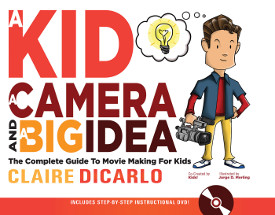A kid a camera and a big idea: The complete guide to movie making for kids by Claire Dicarlo

Buzz Movie Makers, 2014. ISBN 9780987563408.
Movie making is no longer the realm of the big names like Baz
Luhrmann, Sir Peter Jackson and George Lucas. Technology has now put
the tools into the hands of our students and for six years Tropfest,
the world's largest short film festival, has held Trop Jr for film-makers
15 and under. Producing a video is a common assessment task in a
range of circumstances, not to mention the accessibility of YouTube!
But while having the tools and an audience are essential, having the
know-how or access to someone with the know-how to make the movie
stand above others is the critical intermediary step. This book
provides that.
Author Claire Dicarlo is both an actress and a film-maker and her
passion is to get kids to tap into their imaginations, and have the
courage to share their stories with others through film. While she
has founded Buzz Movie Makers in Melbourne and has made over 1000
short films with children, she realised that there were many who
could not access her expertise so this book is the result of trying
to reach them. It is a stand-alone step-by-step guide.
Comprising 27 chapters full of information, explanations, tips,
tricks and the stories of real kids and a DVD that puts the words
into practice so the reader can see what to do, it is the ideal
resource for the budding movie-maker, the art faculty or anyone
wanting to take their movie from 'home-movie' to professional.
Claire speaks directly to the reader as she writes, starting at the
very beginning of the process by having them consider why they want
to make the movie. What is its purpose? Is it to persuade, inform or
entertain and how do they want their audience to feel as a result of
viewing it. Is it take them to a different place or a different
time? These decisions are the foundation of any movie (or writing).
She discusses how to come up with a great idea, how to structure the
story well and how to write a script. There is even a chapter about
how to enter a movie festival and another that enables them to
ensure they comply with copyright in both production and screening.
It is much more than a technical diary. The information is in short
chunks, headings are in question format and there are photos and
illustrations throughout. Tips, examples, case studies and
worksheets for the reader to jot down their own ideas accompany each
chapter.
While Claire's target audience is kids from 9-13 and it is written
so that they can follow it independently to make their own film,
this resource has a real appeal for those like me who would love to
get students doing this, starting with a book trailer, but just
don't have the expertise because movie-making wasn't an accessible
skillset for us as we learned our teaching craft. There is a place
for this both on the general shelves as well as the Teachers'
Resources section and there would be many parents who would welcome
its suggestion as a gift for their budding film-maker.
Crowd-sourced through Pozible
(have a look to see how much putting such a project together costs)
it is an excellent result for those who invested.
Barbara Braxton